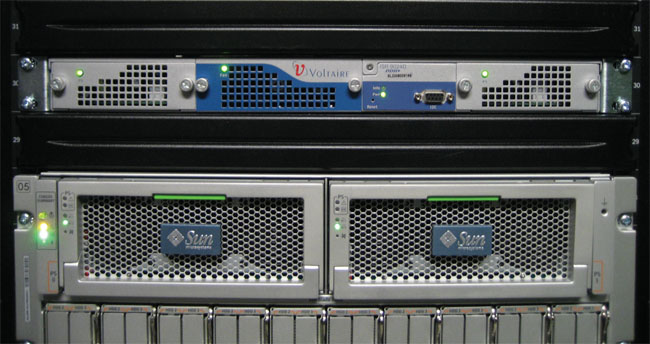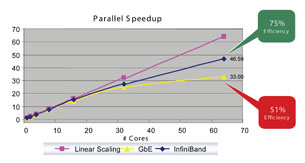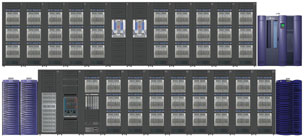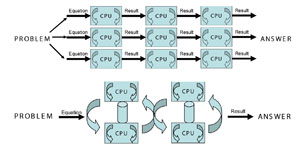Voltaire Accelerates HPC at Mobility Center
Clemson University Computational Center for Mobility Systems creates a world-class research facility with a fast interconnect.
Latest News
October 1, 2009
By Christy Lynch
To help attract leading companies from the automotive industry as well as other industries such as energy, aviation, and aerospace, Clemson University selected Voltaire’s scaleout computing fabric solutions as the interconnect for the high-performance computing (HPC) system operated by the Clemson University Computational Center for Mobility Systems (CU-CCMS). The system enables the university to provide simulation test research to automotive and transportation companies that need to reduce overall design cycle times to develop better products faster and at a lower cost.
 The Clemson University Computational Center for Mobility Systems built a world-class research facility and chose a Voltaire interconnect fabric to tie the 35-teraflop Sun factory-integrated system of servers, networking, and software together. |
To reach its primary goal of fostering innovation in the transportation industry while helping grow the economy of South Carolina, CU-CCMS—located in Greenville, SC—joined with BMW, Michelin, Timken, and other corporate partners as well as leaders from the technology sector to develop a “one-stop shopping” computational engineering center for companies in the mobility industry. The center offers a unique combination of benefits: a multidisciplinary team of experienced, career engineers capable of generating results within budget and the time-scale used in the private sector; a dedicated massive computational infrastructure; and innovative mathematical models developed by CU-CCMS.
 InfiniBand provides much more linear scaling compared to Ethernet by not consuming CPU cycles. This leads to greater system efficiency and scalability. Graph courtesy of HP-Ansys Scalability Benchmark |
“We offer virtual-model testing,” explained James Leylek, Ph.D., executive director of the CU-CCMS. “Compared to physical model testing, this approach allows companies to test new models and components more often and much faster so they can stay ahead of competition and go to market faster.”
Computational simulations that previously required many weeks of processor time are completed at the center within hours, accelerating design cycle times and saving costs. In addition, manufacturers can simulate multiple design options simultaneously by running computations overnight, bypassing the traditional build-and-test cycle, which is costly and time consuming.
The Voltaire Solution
To achieve the center’s mission, Leylek turned to Voltaire’s partner, Sun Microsystems. Sun delivered and installed a 35 teraflop factory-integrated system, including servers, networking, interconnects, and software. The system is based on 43 Sun Blade 6000 Modular Systems, Sun Fire servers, and Sun StorageTek systems. An important piece of the project was choosing the right interconnect fabric for the system.
“To ultimately achieve our goal of reducing simulation testing time, we also needed a server interconnect that would allow the servers to exchange data at maximum speed and with the lowest latency,” Leylek said. “No matter how much computing power you have, if your servers don’t have a fast way to exchange information, you won’t reduce testing times.”
 Sun Microsystems delivered and installed a 35 teraflop system based on 43 Sun Blade 6000 Modular Systems, Sun Fire servers and Sun StorageTek systems. |
After considering Ethernet interconnects, which would not provide sufficient bandwidth or ultra-low latencies, and after testing one other manufacturer’s interconnect that did not perform consistently, CU-CCMS turned to Voltaire. Voltaire recommended that CU-CCMS deploy a 20Gbps InfiniBand fabric using Voltaire Grid Director 2012 and Grid Director 9024 switches to connect all of the Sun servers and interconnect the blade chassis. To further improve the system’s performance, CU-CCMS also selected Voltaire’s 10Gb Ethernet gateways to connect the InfiniBand server fabric to the Sun storage.
“One of our major goals is to help auto manufacturers and their suppliers reduce the total time it takes to bring a new model from initial concept to the showroom,” Leylek said. “Currently, this takes about 36 months. But we will help reduce the overall time to 18 months by significantly reducing the simulation testing time.”
Why Voltaire?
“Everyone we talked to, including our hardware and software partners, as well as our automotive industry partners, reacted positively to our decision to use Voltaire as the interconnect fabric,” Leylek said. “After conducting our research on the performance of Voltaire switches, it allowed us to look our clients straight in the eye and confidently commit to reducing simulation testing times.”
Leylek also knew that Voltaire’s reputation in the automotive industry was already well established. Voltaire has worked with many of the world’s leading automotive manufacturers and more than 20 CAE Independent Software Vendors (ISVs) for several years.
“Voltaire switches provide the bandwidth that any high-performance computing center needs if it’s going to simulate product performance for a manufacturing company,” Leylek said. “The key is to speed-up the testing process, and that’s exactly what Voltaire switches help you accomplish.”
 The top image is an example of an application that requires very little inter processor communication. The problem is broken apart into smaller sub-problems solved individually, assembled into an answer, and fed back to the app. Other applications, however, rely on the tight integration of servers to work together to simultaneously solve a problem and rely on servers that can move data at very high speeds. |
The Results
With the help of the Voltaire fabric, CU-CCMS now gives automotive manufacturers access to a state-of-the-art computing solution that reduces design cycle times and product costs while also providing a place to test new concepts and innovations. The Voltaire solution has also accelerated the performance of numerous CAE applications running on the Sun Microsystems HPC system. In fact, CU-CCMS’s system ranked No. 99 on the November 2008 TOP500 list of the world’s fastest computer systems.
“We have been extremely pleased with the quality and the performance of the Voltaire fabric,” said Leylek. “It enables us to run more simulations in less time than could have been achieved using an Ethernet-based solution.”
In one study with an automotive supplier, CU-CCMS researchers reduced turnaround time for new-product simulation by more than 80 percent. In another case, prototype development that would have required 12 weeks was replaced with a simulation that requires less than 3 weeks—a 75 percent reduction in the time required from concept to results.
Key Results Delivered by Voltaire Solutions Voltaire Products: |
“We provide the performance and scalability testing that the researchers and the businesses need to solve complex design problems,” Leylek said. “The Sun system connected by the Voltaire switches delivers a powerful, high-performance and scalable solution that solves the computing challenges faced by major manufacturing companies.”
CU-CCMS employees use the system to compute, predict, and simulate design problems for a variety of clients in the automotive industry. Some of the tests that the groups run include simulations of computational aerodynamics, vehicle dynamics, acoustics, materials, and manufacturing. However, the automotive industry is just the beginning. In the future, CU-CCMS will expand its services into the aerospace, aviation, and energy industries.
“One specific area of emphasis is gas turbines for jet propulsion, and ground-based turbines for electric power generation,” Leylek says. “We’ve just started talking to some of the global powerhouse companies, and you would be amazed at how impressed they are with the HPC infrastructure here.”
With the help of Voltaire, CU-CCMS has essentially created a one-stop shopping resource for any company involved in manufacturing products for the transportation and mobility industries.
More Info:
CU-Computational Center for Mobility Systems
Christy Lynch works at Voltaire, a provider of scale-out computing fabrics for data centers, high-performance computing, and cloud environments. Send comments about this article to [email protected].
Subscribe to our FREE magazine, FREE email newsletters or both!
Latest News
About the Author
DE’s editors contribute news and new product announcements to Digital Engineering.
Press releases may be sent to them via [email protected].






